
Writers on Twitter Love Data(?!): Introduction
Share
Hey there!
Welcome to the first in a series where I’ll be analyzing Twitter data as I pursue my goal of earning a living wage as a poet. I plan to do this as a monthly recap: sharing data, metrics, spreadsheets, strategy analysis, and general problem-solving. If you’re used to corporate recaps, this might look familiar—but expect more detail. For now, I’m just getting my thoughts on paper; if it resonates, I’ll refine it further. Feedback is always welcome! This first article will be longer to set the stage; future recaps will focus on key takeaways and changes.
(Cross-posted from X.com)
Why am I doing this?
Since diving deeper into the writing community, I’ve noticed that while many writers are confident in their craft, they often feel lost when it comes to marketing and social media. Some even resist the idea of “selling” their work altogether. As a former sales/operations manager, I’ve learned a few key lessons: “Sales is about telling the truth in the most appealing way” and “If you can’t measure it, it didn’t happen.”
-
My goal is to bring some of that perspective to the writing community. You can advocate for yourself (and your work), ask for support, and be outcome-driven in a way that aligns with your core values. And crucially: never lie—not even a little.
-
I’m aware that my direct, corporate approach might not sit well with everyone. There’s a clear disdain for viewing writing as a means to an end, which can sometimes overlap with advocating for oneself. I frequently second-guess how this approach will be received. But that’s exactly why I want to share it: I have a different perspective that might be helpful. Plus, it’s simply who I am.
Let’s dive into the data!
First Steps: Nick - Just Do It
To start, I had two main goals: gain followers and sell my work. Specifically, I aimed to attract “true fans” (inspired by Kevin Kelly’s “1000 True Fans”). My initial hypothesis? Just get on Twitter and start tweeting. Here’s how that played out:
Clearly, this approach wasn’t effective—most of the follows were bots. I needed to provide content that was valuable.
First Pivot: Adding Value
I identified two issues with my initial strategy:
-
Why would anyone care about my thoughts—I’m just a guy on Twitter.
-
How would people even see my tweets?
To address this, I started sharing 3D-printed images inspired by my poems, aiming to cross-promote with Instagram (where I have a small presence). I explained the concepts on Twitter and posted the images on Instagram, directing traffic to my site for purchases and tagging relevant accounts.
This approach was slightly more successful; most follows were genuine. The very straight and artistically executed red lines on the graphs below mark the start of this period:
During this time, I realized I was trying to sell too soon. I hadn’t put in the work to build a following, and no one knew my writing yet. That’s when I noticed other writers posting prompt responses.
Pivot 2: Gaining Traction with Prompts
There were challenges with the 3D-printing strategy: it was too labor-intensive for each tweet, especially as I was still learning the ropes. I decided to simplify my goal to focus on gaining “real” followers while creating content—two birds, one stone.
Here is a thread I posted that summarizes my mindset in the moment:
I noticed that prompts have built-in audiences, and communities provide a similar advantage. By writing prompt poems, I could improve my short-form writing, create content for Instagram, and increase visibility—all while doing what I enjoy. So, I wrote 52 prompt responses between 8/13-8/31, experimenting with posting in communities versus on my own.
While community posts had higher reach, they felt less authentic. My first two poems in communities received over 4,000 impressions each.
Here's more virtuosic line-drawing on graphs:
The peaks circled in blue show results from targeting trending topics and responding to popular tweets with topical poems, alongside regular prompt responses.
Towards the end, I hit a slowdown—writing 52 twitter poems (plus about 15 others) in 18 days isn’t sustainable. But more importantly; I started making another pivot - I learned a lot, gained followers, and started brewing new ideas for September. (Stay tuned for the next recap!)
Results:
After clearing out ~200 fake followers, I now have ~109 genuine follows, new friends, and a stronger sense of community. I also have a solid collection of poems and improved my short-form writing skills.
Wait! What about all those other metrics?
Metrics like impressions, engagements, and profile visits serve as leading indicators of progress. They help me assess whether I’m on track or if adjustments are needed. While these metrics aren’t the ultimate goal, they provide valuable insights that guide me toward achieving the desired outcomes. They can communicate a lot, and I’ll dive deeper into how to use them effectively as relevant situations come up in future updates.
For now, the general rule is simple: more is better.
Conclusion/Takeaways
-
Create content that people care about.
-
Share it in spaces with built-in communities.
-
Set clear goals.
-
Avoid overcomplicating things.
-
Trust the process.
-
I like data.
I’d love to hear your thoughts on this! Let me know if you enjoyed it and especially if you have any feedback.
Humans should never be just a means to an end. So don't just be a leading indicator (impression, engagement, profile visit); give me a follow (@rerollinghuman) and stay tuned for the next monthly recap!





